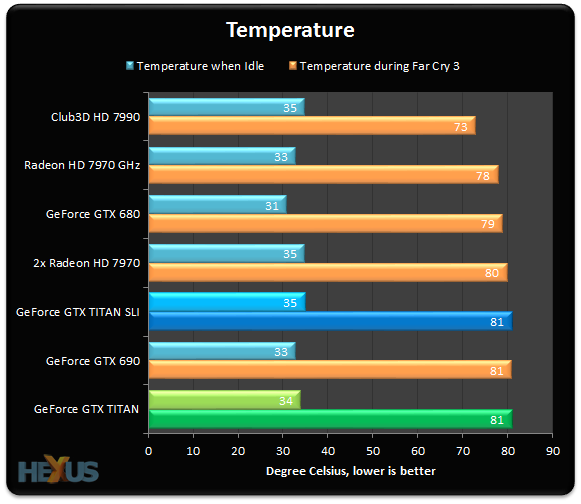Power, thermals, acoustics and conclusion

A single card's excellent power-draw characteristics enable two cards to pull, as a system, less than 500W at the mains. We use a Corsair AX750W power supply that had no problems driving a Core i7-3770K/twin TITAN setup with ease.

And, just like for a single card, the temperature-modulating GPU Boost v2.0 ensures that the cards keep as close to the default 80°C as possible.

Excellent single-card acoustics bode well for two cards. The combined noise is actually not as loud as the decibel rating suggests, with the Corsair PSU's fan also increasing in volume as the load is increased. The two cards are fundamentally quieter than either the Radeon HD 7990 or two HD 7970s.
Concluding thoughts
NVIDIA's GeForce GTX TITAN lays claim to being the fastest single-GPU card ever produced for the gaming crowd. The rise of multiple GPUs on one card - GeForce GTX 690 and Radeon HD 7990 being prime examples - means that TITAN, while absurdly quick, isn't the best graphics card in town.
Adding a second GTX TITAN, and thereby inflating the graphics budget to £1,650, bring with it near-perfect scaling in Far Cry 3, Crysis 3 and Sleeping Dogs but less-pronounced increases in other titles. The upshot is that TITAN SLI doesn't beat other single boards in all tests, which may come as a surprise to some readers.
Having two TITAN cards demands that users game at exotic resolutions, 5,760x1,080, at a minimum, and have a quality CPU backing up the GPUs' efforts. Would we spend £1,650 on this kind of graphical performance? The answer is no, because the numbers - and it's all about the numbers here - intimate that a couple of price-equivalent GTX 690s or HD 7990s would be quicker.
We're intrigued to find out if three-way SLI can offer ultimate performance, and we'll be comparing it to two GTX 690s and a couple of HD 7990s. Stay tuned for that.













